Fractional folles, sometimes called "quinarii." Late Roman coins at Trier.
For some unknown reason beginning c. 290 a few fractional folles were issued, mostly at Trier. Most types celebrate vows for ten-year and twenty-year anniversaries with small issues of small laureate coins. I follow Zschucke in calling them "fractions." (These are not the larger so-called "quarter follis" coins of Siscia with GENIO POPVLI ROMANI.) Zschucke lists 263 fractional varieties from Trier, c. AD 290-321. Some scholars think some of those were actually minted at Lyon, Ticinum, and Siscia (I am not able to, and do not, distinguish the mints, which are usually identified by find spots because they do not have mint marks). We do not know the ancient names of these small denominations, nor are we certain how they relate to the other denominations before and after Diocletian's coin reform of c. 294 (the pre-reform "aurelianus," the post-reform "follis" a.k.a. "nummis," the post-reform radiates, and the silver argenteus). Zschucke calls them "1/8" (the smaller ones) and "1/4" (the larger ones) with a few later ones under Constantine called "1/2." Dealers often call them "quinarii," which would be half a denarius. It may be that they are fractions of the nominal denarius communes which is later mentioned in Diocletian's Edit on Maximum Prices. Unusual small coins like these were issued in the names of emperors Diocletian through Crispus and Constantine II. The last issue is from when Constantine issued a VOT XX MVLT XXX type, c. 320, or maybe 326.
What's new? 2020, March 16: Constantine as Caesar.
The first two images make their small size clear.
 Diocletian, AD 284-305
Diocletian, AD 284-305
14 mm. 2.00 grams. The small "1/8 follis" denomination.
DIOCLETI-ANVS AVG
VOT/XX/AVGG in wreath
RIC VI Trier 610a.
Zschucke 4.2
Struck c. September 303 [RIC and Zschucke agree]
for the festival occasion celebrating vows for twenty years. Fractional folles are much smaller than folles. Next is a regular follis to scale.
Diocletian, AD 284-305
27-26 mm. 9.23 grams.
GENIO POPVLI ROMANI
Struck c. 302-3 at Trier.
The next coin is the larger fractional denomination.
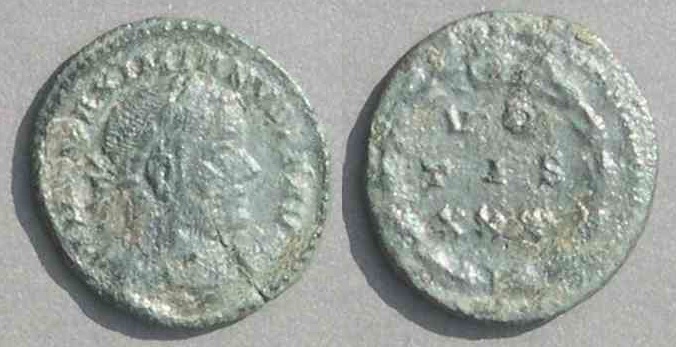
Maximian, second reign, struck summer 307
18-17 mm. 1.98 grams. "1/4"
Struck summer 307 for his second reign, taking vows for 30 years.
VO/TIS/XXX
RIC VI Trier 754 page 214 "R, c. summer 307"
Zschucke 7.14, page 48. "1/4, by Constantine, for July 25, 307."
 Maximian, second reign, 306-308
Maximian, second reign, 306-308
14-13 mm. 1.08 grams. "1/8"
VOT/XXX/AVG
Note "AVG" has only one "G". Previously emperors with a co-ruler used "GG" so he is denying the existence of an equal co-ruler.
RIC VI Trier 751, page 214, "R4, c. summer 307"
Zschucke 6.7a (this coin) "by Constantine, for July 25, 307."
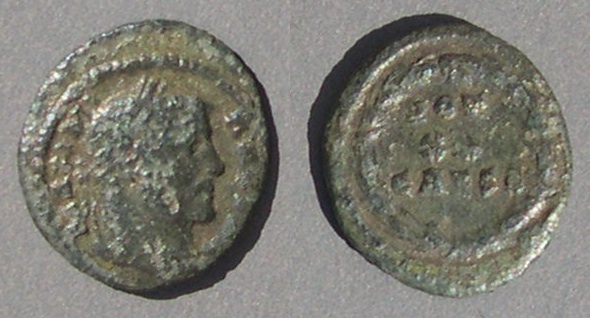 Galerius
Galerius
15-14 mm. 1.50 grams. "1/8"
Struck as Caesar c. Sept. 303 at Trier.
At this time Galerius had ruled as Caesar for ten years and was renewing vows for twenty years.
MAXIMI-ANVS NC
VOT/XX/CAESS
RIC Trier 611 "R3, c. Sept. 303"
Zschucke 4.7, "for the vicennalia of Diocletian in September 303."
The Second Tetrarchy. Fractions record wows taken when the Caesars were promoted to Augusti and new Caesars were created.
 This coin marks the promotion of Constantius from Caesar to Augustus.
This coin marks the promotion of Constantius from Caesar to Augustus.
The second next coin, from the same occasion, marks the promotion of Severus II to Caesar.
Constantius, Caesar 293-305 and Augustus 305-306.
14-13 mm. 1.53 grams. "1/8"
CONST-ANTIVS AVG
VOT/XX/AVGG
RIC VI Trier 682a, "R2, 305-306"
Zschucke 5.5 (no photo) struck for May 1, 305, the abdication of the Augusti and elevation of the Caesars to Augusti.
M&M 61, Bastien collection 708.
Next is a very similar type with slightly different legend.
 Constantius, Caesar 293-305 and Augustus 305-306.
Constantius, Caesar 293-305 and Augustus 305-306.
13 mm. 0.90 grams. "1/8"
CONST-ANTIVS AVG
VOT/XX/AVGG/NN
RIC VI Trier 684, "305-306"
Zschucke 5.11 struck for May 1, 305, the abdication of the Augusti and elevation of the Caesars.
This coin marks the promotion of Constantius from Caesar to Augustus. The next coin is from the same occasion.
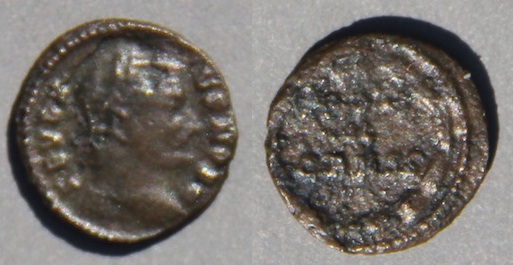 This coin marks the promotion of Severus II to Caesar.
This coin marks the promotion of Severus II to Caesar.
Severus II, Caesar 305-306. Augustus 306-307.
13-12 mm. 1.09 grams. "1/8"
Struck for May 1, 305 (the abdication of the Augusti and elevation of the Caesars) for his elevation to Caesar.
SEVER-VS NOB C
VOT/X/CAESS
RIC Trier 685a "R2, 305-6"
Zschucke 5.13 "1/8", for May 1, 305.
The two elevated Caesars were Severus II (in the west) and Maximinus II (in the east).
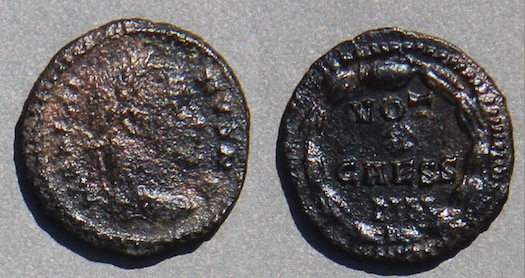 This coin marks the promotion of Maximinus II to Caesar.
This coin marks the promotion of Maximinus II to Caesar.
Maximinus II, Caesar 305-306. Augustus 306-313.
13 mm. 1.21 grams. "1/8"
MAXIMI-NVS NC
VOT/X/CAESS/NN
RIC Trier 688 "R5, 305-6"
Zschucke 5.17 (this coin) "1/8", for May 1, 305.
Struck for May 1, 305 (the abdication of the Augusti and elevation of the Caesars) for his elevation to Caesar.
Constantinian. Small denominations continued under Constantine. All are rare. The follis was reduced in size, so small coins of a given size are now described as greater fractions. The old "1/8" size is the new "1/4" and the old "1/4" size is the new "1/2."
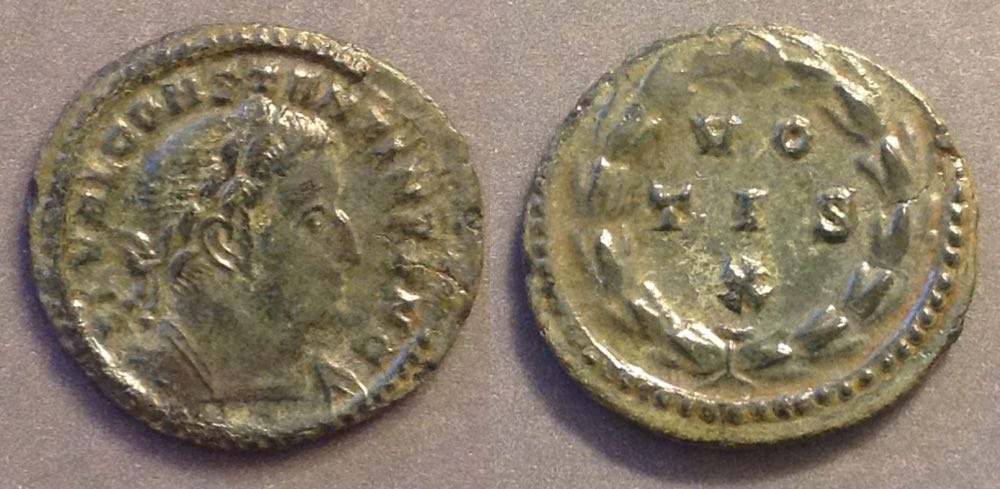 Constantine as Caesar, 306-307, struck summer 307
Constantine as Caesar, 306-307, struck summer 307
18-17 mm. 1.98 grams.
FL VAL CONSTANTINVS N C
VO/TIS/X in wreath
RIC VI Trier 750
Zschucke 7.13, page 47
 Constantine, as Augustus 307-337.
Constantine, as Augustus 307-337.
13 mm. 1.27 grams. "1/4"
CONSTANTINVS AVG
VO/TIS/X
RIC VI Trier 906, "R, 310-311"
Zschucke 11.4 (this coin) page 52, struck for the quinquenalia, July 25, 310.
That is, struck at celebrations for five years, with vows taken for 10 years.
Note how much the size had decreased since the same type was minted as Caesar.
Until Constantine, vota coins were generally struck either at the beginning of the reign (vota suscepta, vows taken) or after ten years (vota soluta, vows paid). RIC and Zschucke date this coin as if there were a vota occasion for Constantine at five years. There are not "VOT V" coins to mark it, but "VOT V" was a type introduced later on coins of his sons Crispus and Constantine II, and of Licinius II for their quinquennalia (5-year celebration) c. 321. See the third coin below. I am not convinced that we have the evidence necessary to date these coins correctly.
 Constantine, Caesar 306-307 and Augustus 307-337.
Constantine, Caesar 306-307 and Augustus 307-337.
13 mm. "1/4"
CONSTANTINVS AVG
VOT/X/MVL/XX
RIC VI Trier 913 page 228 "R2, 310-311"
Zschucke 11.19-20, struck for the quinquinalien, July 25, 310.
That is, struck at celebrations for five years, with vows taken for both 10 and 20 years.
This type, which Zschucke calls a "1/4", has the same size that the "1/8" had earlier. Similarly, the following "1/2" resembles the earlier "1/4". The follis had gotten smaller, so the fractions did too.
 Constantine, as Augustus 307-337.
Constantine, as Augustus 307-337.
16 mm. 1.38 grams. "1/2"
CONSTANTINVS PF AVG
VOT/XX/MVLT/XXX
RIC -- (Thessalonica 54 is close, but Zschucke shows the very rare "Thessalonica" coins in RIC are really from Trier.)
Zschucke 14.11a (this coin) page 62, struck at Trier for July 25, 320, the quinquenalia of Constantine. (I don't know what evidence we have that this date is right. On its face, it belongs to 326 when his vows for 20 years would have been paid and renewed for 30 years).
This coin is dated as if there were celebrations at 15 years in which vows for 20 and 30 were taken simultaneously.
 Crispus, Caesar 317-324.
Crispus, Caesar 317-324.
16 mm. 2.22 grams. "1/4"
FL IVL CRISPVS NOB CAES
VOT/V/CAESS/NN
RIC VII Trier 339, page 193,"R5, 321-2"
Zschucke 14.18, for the quindecennalia (15-year celebrations)) of Constantine on July 25, 320, and the quinquenalia (5-year celebrations) of the Caesars (320/321) including Crispus and the 70th birthday of Helena (March 321).
This type and the regular AE3 "VOT V" type common for Constantine II are the first to mention vows for five years (as opposed to ten or a multiple of ten).
The quindecennalia (15-year ceremony) of Constantine on July 25, 320, and the quinquennalia (5-year ceremony) of the Caesars (320/321) were the last occasions for which these fractional denominations were minted at Trier. They are all rare. There can never have been enough of them to play a significant role in the monetary system. Possibly they served as small change in the region of Trier, but the denominations did not catch on at other mints.
Note for Collectors: These fractions are all rare and seldom offered. Few are in excellent condition and many have "problems" such as a lot of wear or corrosion. Examples are hard to search for on-line because they do not have a distinctive, agreed-upon name. Occasionally the denomination is called a "quinarius" because it is small like a silver quinarius was in the first through third centuries. The search term "fraction" might find a few. The search term "quarter follis" finds many coins of Siscia that are not in this series (and which are sometimes called "denarii"). The term "half follis" finds many Byzantine coins with "K" on them. The search term "eighth follis" does not find anything; the name has not been adopted.
RIC attributes, with hesitation, some extremely rare types to Thessalonica (Volume VII, page 505), but Zschucke argues they are actually from Trier because, since RIC was written, examples of those types have been found at Trier (page 21). The scholar Pierre Zanchi wrote me, "many of these quinarii/fractional pieces were actually struck in Lyon, Ticinum, and Siscia."
A Note on the Denominations. The "denarius communis" is a denomination mentioned in the "Edict of Maximum Prices" under Diocletian (c. AD 300), but it is primarily a money of account as opposed to an actual coin. In any case, in spite of assertive statements (e.g. by Harl) or conjectures (by many others) about the value of the follis (nummis) and the other denominations in terms of denarii, scholars do not agree on which coins correspond to which values. Among more than 1200 prices given in the Edict, only 2 are of "1 d.c." 26 are of "2," 1 is of "3," 94 are of "4," and 1 is of "5" [Cope]. If any of these small coins are actually denarii we don't know which ones.
References:
Zschucke, Carl-Friedrich. Die Bronze-Teilstuck-Pragungen der Romischen Mumzstatte Trier. 1989. 65 pages including 16 page plates of coins.
[A complete list of all the fractional AE from Trier (263 types, not including those from Rome or other mints) issued under the tetrarchy and later. This is the (small) book you need for these issues. However, it does not cover those minted at Rome. You will need RIC for those.]
Failmezger, Victor. Roman Bronze Coins: From Paganism to Christianity, 294-364 AD. [A bare list of types with 6 photos, however, without significant discussion.]
Harl, Kenneth. Coinage in the Roman Economy, 300 BC to AD 700. 1996. Harcover. 533 pages and 267 coins on 32 page plates. [This is a very interesting book with a great deal of good information. However, for the coins of the late third and fourth centuries Harl states his inferences about denominations and their relationships to each other as if they were accepted facts, which is far from the case. Many other scholars disagree with his interpretation of "XXI" on coins after Aurelian and many disagree with his assertions about the number of "denarii communis" to be assigned to the post-reform denominations under Diocletian. It is disappointing that in what is otherwise such a good book he does not discuss the controversies.]
Cope, Lawrence. "Diocletian's Price Edit and its associated coinage denominations," in Schweizer Munzblatter, Feb. 1977, pages 7-12.
[This is only one among many articles with competing explanations of the denominations under Diocletian. I do not know that any resolve the question of the names of the denominations of the small coins which are the subject of this web page.]
Roman Imperial Coinage (RIC), volumes VI and VII.
Sale Catalogs: The two M&M sale-catalog references below have excellent representations.
M&M Basel (= Munzen und Medaillen A.G. Basel = Monnaies et Medailles S.S. Bale. Switzerland.)
XIII (17-19 June 1954) VHV. MQP. 1051 ancients among 1225 on 36 ppl + 2 E among 48. A spectacular collection of coins of the tetrarchy, including very many rare copper fractional pieces and many silver argentei and many antoniniani. Also some late Roman gold, 99 outstanding RP, 260 G.
Tetrarchy (345), including late Roman fractions (78) and silver argentei (129 regular and 20 irregular)
61 (10/82) VHV and MV. MQP. 1466 lots of ancients on 72 ppl + 2 E. Divided into two parts. The first part of the catalog is a typical selection of VHV Greek and Roman coins. A second part is the Pierre Bastien Collection of late Roman AE. 239 G, 156 Roman Republican, 132 R, 9 spintriae, and then 926 lots of late Roman AE on 32 ppl. (Only tetrarchy and Constantinian family, not Valentinian and later.) All the late Roman AE are in outstanding condition and many lots consist of all the co-emperors of the same issue, although only one per type is usually illustrated. Over 40 of the rare fractional bronze are illustrated. This is the finest sale catalog of late Roman AE ever issued.
late Roman AE (926 lots) including 40 fractional AE (quinarii)
Go to the page on VOTA coins.
Leave the pages on vota coins and go to the main Table of Contents page for these educational pages.
 Diocletian, AD 284-305
Diocletian, AD 284-305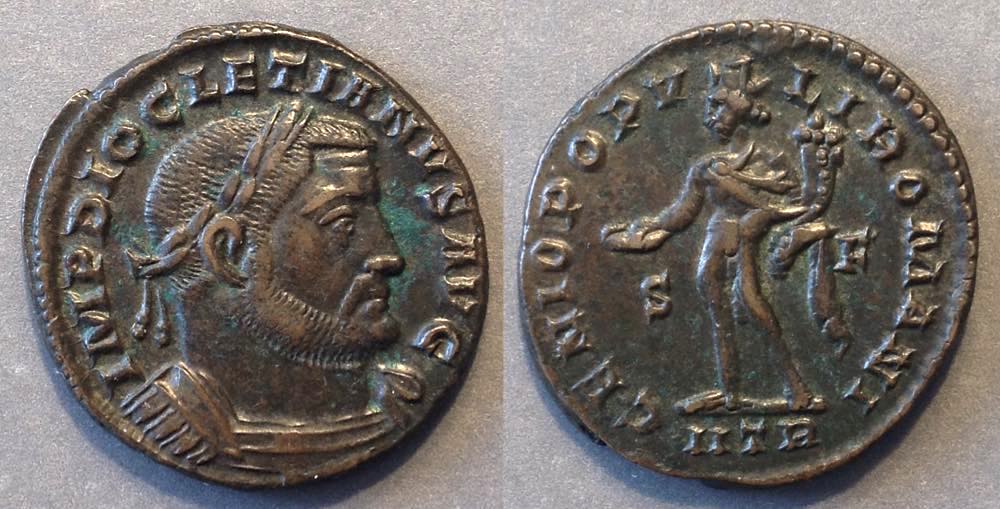

 Maximian, second reign, 306-308
Maximian, second reign, 306-308 Galerius
Galerius This coin marks the promotion of Constantius from Caesar to Augustus.
This coin marks the promotion of Constantius from Caesar to Augustus. Constantius, Caesar 293-305 and Augustus 305-306.
Constantius, Caesar 293-305 and Augustus 305-306. This coin marks the promotion of Severus II to Caesar.
This coin marks the promotion of Severus II to Caesar. This coin marks the promotion of Maximinus II to Caesar.
This coin marks the promotion of Maximinus II to Caesar. Constantine as Caesar, 306-307, struck summer 307
Constantine as Caesar, 306-307, struck summer 307 Constantine, as Augustus 307-337.
Constantine, as Augustus 307-337. Constantine, Caesar 306-307 and Augustus 307-337.
Constantine, Caesar 306-307 and Augustus 307-337. Constantine, as Augustus 307-337.
Constantine, as Augustus 307-337. Crispus, Caesar 317-324.
Crispus, Caesar 317-324.